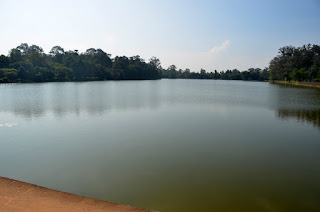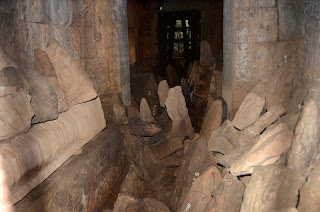And another reason is that; jotting down everything that I encounter and experience is what I want to do; but its a draining process; since there is so much; this much; to write. I promise myself that I will be regular and more importantly on time to jot them down here. I shudder to think that my Sri Lankan trip has also been on the line to complete.
Anyway, continuing on Angkor temples. The Angkor Wat, Bayon and Ta Prohm also now referred to as Angelina Jolie temple after few scenes were shot for the movie Tomb Raider are all part of Little Circuit. The temples in the little circuit are all mostly at shorter distances from one another and they are also huge temples.
The day starts at 4 am to be on time to watch the sun rise at Angkor Wat temple. However early you go, you always see crowds that have gathered before your arrival; such is the name and fame of Angkor Wat. Many people place their tripods strategically to capture the sun rise which is again very famous. You need to find a spot to watch the beauty of the sunset and also to take a good pic. Just along the side where people gather to watch sun rise are number of restaurants. Tourists generally take a break for a while after watching sunset to have a hearty breakfast to prepare for their long and exhaustive day ahead; before entering the temple.
These restaurants are just tiny shacks with a couple of plastic chairs and tables; and they are in a row. Each restaurant has a unique name and they are international that can be easily identified by the tourist. The guys and women owners of these shacks walk up to you and mention the restaurant name and the number and ask you to visit them for breakfast after watching sun set. One of the shack could be "Number 4 James Bond" or another one "Number 6 Britney Spears". The strategy is simple; have a name a Westerner can recognize. So you will have them nagging you constantly to visit "Stall no 4 James Bond" for good breakfast.
The shacks that are strategically placed closer to sunrise viewing area are the ones that most people visit; very few venture to the far end. The stalls at the far end have to struggle very hard to get business. There was thing one guy who was not more than 12 years old who had an impeccable English with an American accent. This boy owned or maybe worked in a stall at the far end of the row. He was dirty looking, ragged, wearing torn clothes. You might easily mistake him for a poor Cambodian tramp until he starts speaking. He is poor yes, but his business acumen was laudable. I can never forget him. He came unto us and started(in American impeccable English) "Sir, ma'am would you care for some Coffee and breakfast? My stall is on the left; please sir, this way. This way ma'am"
When we said we will return after watching the sunset, he replied "Sure ma'am. Remember my stall. Pleasure to have you here". Now, the way he approached, his confidence, his etiquette; I am not one bit exaggerating. You get to learn all of that in a business school paying lakhs of rupees. It was unfortunate that we couldn't go to his stall at the far end later; because we were hijacked mid way by a couple and hungry that we were; we settled at the nearest one. The boy was disappointed and said "This is unfair!" and forgot about it the next moment and went off to pursue other tourists. But observing him through the breakfast; it was obvious that people had no patience to go unto his stall and he lost many customers. While the front stalls got quick customers about 5-6 in 20 mins; he managed just one. When life challenges your existence, you find a way; isn't it?
So the much awaited sun rise at Angkor Wat
The temple of Angkor Wat is one of the largest of the Khmer temples built during the 12th century as Hindu temple. The size of the monument is overwhelming and its not surprising that you need 4-6 hours to soak it up. We started at 6 AM and finished it at 10 AM. There is a "how to explore" guide on the internet. The temple follows the plan of Meru mountain; the secret mountain and thus the five towering gopuras. The outer compound has libraries. The bas reliefs at the main entrance depict stories from the battle of Ramayan and Mahabharat, churning of the ocean by demons and gods to get Amruta, army of the King Suryavarman II and other similar ones on both left and right side.
Ram and Lakshman
Ravana at war against Ram
A partial view of the lengthy bas reliefs
Wooden stair cases to help tourists walk without falling off and also to protect the monument
An Apsara
Scene depicting Mahabharata war
Bhishma pierced by 1000 arrows
These were richly colored; some of the partial colors can be seen here. Imagine the temple in its heydays; richly colored; sculptures studded with precious stones...such grandeur.
Sri Krishna riding the chariot
King Suryavarman II and his ministers giving audience
Soldiers marching to war with horses and elephants
Khmers going to war against Chams
These are Cham soldiers
A day in the life of Khmers
A general going to war
The king going to war. How do we know he is the king? By the number of parasols he is accompanied with
The entrance to inner courtyard
Vandalized images of Hindu gods; the organic color remains
One of the towers
Inside the temple
The last tier
The central courtyard has lot of apsaras
Some more
A pediment richly carved
The topmost central courtyard has images of Buddha; they are worshiped
As seen from above
Another image of Buddha with the Buddhist flag
The central courtyard
A monk
The steps to the top
The pond and on the other side are the stalls
The baray













































































